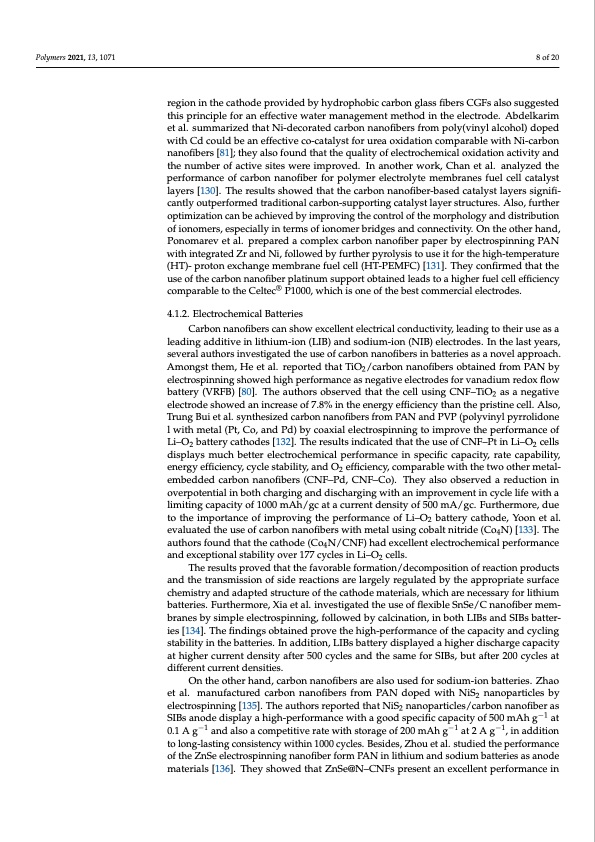
PDF Publication Title:
Text from PDF Page: 008
Polymers 2021, 13, 1071 8 of 20 region in the cathode provided by hydrophobic carbon glass fibers CGFs also suggested this principle for an effective water management method in the electrode. Abdelkarim et al. summarized that Ni-decorated carbon nanofibers from poly(vinyl alcohol) doped with Cd could be an effective co-catalyst for urea oxidation comparable with Ni-carbon nanofibers [81]; they also found that the quality of electrochemical oxidation activity and the number of active sites were improved. In another work, Chan et al. analyzed the performance of carbon nanofiber for polymer electrolyte membranes fuel cell catalyst layers [130]. The results showed that the carbon nanofiber-based catalyst layers signifi- cantly outperformed traditional carbon-supporting catalyst layer structures. Also, further optimization can be achieved by improving the control of the morphology and distribution of ionomers, especially in terms of ionomer bridges and connectivity. On the other hand, Ponomarev et al. prepared a complex carbon nanofiber paper by electrospinning PAN with integrated Zr and Ni, followed by further pyrolysis to use it for the high-temperature (HT)- proton exchange membrane fuel cell (HT-PEMFC) [131]. They confirmed that the use of the carbon nanofiber platinum support obtained leads to a higher fuel cell efficiency comparable to the Celtec® P1000, which is one of the best commercial electrodes. 4.1.2. Electrochemical Batteries Carbon nanofibers can show excellent electrical conductivity, leading to their use as a leading additive in lithium-ion (LIB) and sodium-ion (NIB) electrodes. In the last years, several authors investigated the use of carbon nanofibers in batteries as a novel approach. Amongst them, He et al. reported that TiO2/carbon nanofibers obtained from PAN by electrospinning showed high performance as negative electrodes for vanadium redox flow battery (VRFB) [80]. The authors observed that the cell using CNF–TiO2 as a negative electrode showed an increase of 7.8% in the energy efficiency than the pristine cell. Also, Trung Bui et al. synthesized carbon nanofibers from PAN and PVP (polyvinyl pyrrolidone l with metal (Pt, Co, and Pd) by coaxial electrospinning to improve the performance of Li–O2 battery cathodes [132]. The results indicated that the use of CNF–Pt in Li–O2 cells displays much better electrochemical performance in specific capacity, rate capability, energy efficiency, cycle stability, and O2 efficiency, comparable with the two other metal- embedded carbon nanofibers (CNF–Pd, CNF–Co). They also observed a reduction in overpotential in both charging and discharging with an improvement in cycle life with a limiting capacity of 1000 mAh/gc at a current density of 500 mA/gc. Furthermore, due to the importance of improving the performance of Li–O2 battery cathode, Yoon et al. evaluated the use of carbon nanofibers with metal using cobalt nitride (Co4N) [133]. The authors found that the cathode (Co4N/CNF) had excellent electrochemical performance and exceptional stability over 177 cycles in Li–O2 cells. The results proved that the favorable formation/decomposition of reaction products and the transmission of side reactions are largely regulated by the appropriate surface chemistry and adapted structure of the cathode materials, which are necessary for lithium batteries. Furthermore, Xia et al. investigated the use of flexible SnSe/C nanofiber mem- branes by simple electrospinning, followed by calcination, in both LIBs and SIBs batter- ies [134]. The findings obtained prove the high-performance of the capacity and cycling stability in the batteries. In addition, LIBs battery displayed a higher discharge capacity at higher current density after 500 cycles and the same for SIBs, but after 200 cycles at different current densities. On the other hand, carbon nanofibers are also used for sodium-ion batteries. Zhao et al. manufactured carbon nanofibers from PAN doped with NiS2 nanoparticles by electrospinning [135]. The authors reported that NiS2 nanoparticles/carbon nanofiber as SIBs anode display a high-performance with a good specific capacity of 500 mAh g−1 at 0.1 A g−1 and also a competitive rate with storage of 200 mAh g−1 at 2 A g−1, in addition to long-lasting consistency within 1000 cycles. Besides, Zhou et al. studied the performance of the ZnSe electrospinning nanofiber form PAN in lithium and sodium batteries as anode materials [136]. They showed that ZnSe@N–CNFs present an excellent performance inPDF Image | Electrospun Carbon Nanofibers from Biomass and Biomass Blends

PDF Search Title:
Electrospun Carbon Nanofibers from Biomass and Biomass BlendsOriginal File Name Searched:
88145ac687f0c36c7096f236fabe2cba856c.pdfDIY PDF Search: Google It | Yahoo | Bing
Sulfur Deposition on Carbon Nanofibers using Supercritical CO2 Sulfur Deposition on Carbon Nanofibers using Supercritical CO2. Gamma sulfur also known as mother of pearl sulfur and nacreous sulfur... More Info
CO2 Organic Rankine Cycle Experimenter Platform The supercritical CO2 phase change system is both a heat pump and organic rankine cycle which can be used for those purposes and as a supercritical extractor for advanced subcritical and supercritical extraction technology. Uses include producing nanoparticles, precious metal CO2 extraction, lithium battery recycling, and other applications... More Info
| CONTACT TEL: 608-238-6001 Email: greg@infinityturbine.com | RSS | AMP |